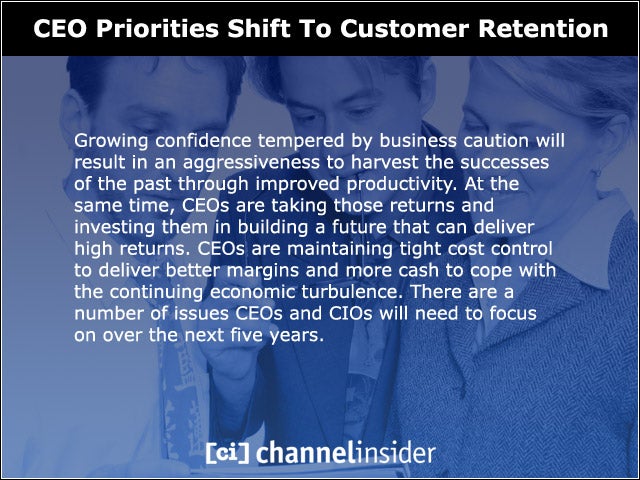 CEO Priorities Shift To Customer Retention
CEO Priorities Shift To Customer Retention
Growing confidence tempered by business caution will result in an aggressiveness to harvest the successes of the past through improved productivity. At the same time, CEOs are taking those returns and investing them in building a future that can deliver high returns. CEOs are maintaining tight cost control to deliver better margins and more cash to cope with the continuing economic turbulence. There are a number of issues CEOs and CIOs will need to focus on over the next five years.
 Getting To the End Of Restructuring
Getting To the End Of Restructuring
CEOs are still focused on streamlining their business operations, dumping nonperforming or nonstrategic assets, and working to ensure that they don’t increase their exposure to another economic shock. Many are "financing" initiatives that will improve their cost structure or allow them to drive revenue as the economy recovers by taking a very hard look at not only their internal cost structures, but that of partners in their ecosystems. CIOs are advised to expect to “finance” future IT projects from the cost savings obtained in other parts of operations.
 Integrity, Corruption and Fraud—Rebuilding Trust
Integrity, Corruption and Fraud—Rebuilding Trust
CIOs should expect to see increased interest in capabilities and technologies that help provide transparency to internal operations of the sort that increases trust. More openness will surround the financial structure of the organization, and expenses will be examined to high levels of detail. Business intelligence will see strong interest in this time frame.
 Playing Defense, While Playing Offense
Playing Defense, While Playing Offense
This year is about CEOs taking a firm stand on plans for increasing shareholder value. This may be through acquisitions that are less expensive in a time of lower equity pricing or lower capital costs. It may also be about investing in initiatives that achieve a strategic goal.
 Organizations Are Of Two Minds
Organizations Are Of Two Minds
CIOs need to understand that organizations are investing in the innovations that will build the future, while guarding against the possibility of another economic recession or crisis in the next 36 months. CIOs must ensure that they are able to segment the activities of the organization so that each part of the team can focus on what is most important: One team takes care of cost optimization activities, while another is focused on the future.
 Government Is The New Partner At The Table
Government Is The New Partner At The Table
The tumultuous economic effects of the banking crises of 2007 and 2008 have driven swift and large-scale government interventions to bail out and save companies, and more market interventionist and state control styles of government may arise from this situation. The resulting new regulations will require compliance by any new systems. Several areas will see new regulatory actions in the coming 24 months, including the financial services, automotive and transportation sectors. CIOs need to keep scanning the landscape of regulatory actions in federal, state and local governments, as the pace is expected to pick up in 2011.
 The Future of Recession-Driven Changes
The Future of Recession-Driven Changes
One of the key issues in the boardroom is to understand the future of the changes forced by this recession. Will the growth in all industries return to the levels that were enjoyed before the downturn? Will the drive to improve process efficiencies be long-lasting, or will there be a marked return to a top-line focus in the business?
 IT Has Significant Role To Play
IT Has Significant Role To Play
Gartner believes that IT has a significant role to play here because it needs to deliver insights for the business to enable it to effectively navigate the changes ahead. IT must make investments in understanding customer intent, predicting the impact of business conditions and connecting strategy to outcomes.
 Additional Load On IT
Additional Load On IT
These long-lasting changes place quite an additional load on IT. The long-term focus on efficiencies to reduce exposure to another financial crisis will continue to force IT to make the business of the past more productive, while IT must invest in the future at a rate that does not grow IT costs faster than the business.
 New IT Culture
New IT Culture
CIOs should build an IT culture of intolerance toward inefficiency and impatience for the gains from newer lighter-weight technologies such as social networking, virtualization and mobile device apps.

